Interface and Size Effects of Amorphous Si/Amorphous Silicon Oxynitride Multilayer Structures on the Photoluminescence Spectrum
Abstract
:1. Introduction
2. Experiment
3. Results and Discussion
4. Conclusions
Author Contributions
Funding
Institutional Review Board Statement
Informed Consent Statement
Data Availability Statement
Conflicts of Interest
References
- Pavesi, L.; Dal Negro, L.; Cazzanelli, M.; Pucker, G.; Gaburro, Z.; Prakash, G.C.; Franzo, G.; Priolo, F. Optical gain in silicon nanocrystals. Natures 2001, 4293, 162–173. [Google Scholar] [CrossRef]
- Meng, L.; Li, S.; Chen, H.; Lei, M.; Yu, G.; Wen, P.; Fu, J.; Jiang, S.; Zong, H.; Li, D.; et al. In-situ fabricated amorphous silicon quantum dots embedded in silicon nitride matrix: Photoluminescence control and electroluminescence device fabrication. J. Lumin. 2023, 261, 119913. [Google Scholar] [CrossRef]
- Hegedüs, N.; Balázsi, K.; Balázsi, C. Silicon Nitride and Hydrogenated Silicon Nitride Thin Films: A Review of Fabrication Methods and Applications. Materials 2021, 14, 5658. [Google Scholar] [CrossRef] [PubMed]
- Tuan, N.T.; Thu, V.V.; Trung, D.Q.; Tu, N.; Tran, M.T.; Duong, P.H.; Anh, T.X.; Hong, N.T.; Loan, P.K.; Tam, T.T.H.; et al. Huy, On the origin of photoluminescence enhancement of Si nanocrystals on silica glass template and Si/SiO2 superlattice. Phys. B Condens. Matter 2023, 662, 414970. [Google Scholar] [CrossRef]
- Dey, P.P.; Khare, A. Fabrication of luminescent a-Si: SiO2 structures by direct irradiation of high power laser on silicon surface. Appl. Surf. Sci. 2014, 307, 77–85. [Google Scholar] [CrossRef]
- Bonilla, R.S.; Al-Dhahir, I.; Yu, M.; Hamer, P.; Altermatt, P.P. Altermatt, Charge fluctuations at the Si-SiO2 interface and its effect on surface recombination in solar cells. Sol. Energy Materials Sol. Cells 2020, 215, 110649. [Google Scholar] [CrossRef]
- Sondhi, K.; Sharangpani, R.; Tirukkonda, R.; Nag, J.; Guo, X.-C.; Gribelyuk, M.A.; Makala, R.S.; Kanakamedala, S. Extending area selective deposition of ruthenium onto 3D SiO2-Si multilayer stacks. J. Vac. Sci. Technol. A 2023, 41, 050402. [Google Scholar] [CrossRef]
- González-Flores, K.E.; Frieiro, J.L.; Horley, P.; Pérez-García, S.A.; Palacios-Huerta, L.; Moreno, M.; López-Vidrier, J.; Hernández, S.; Garrido, B.; Morales-Sánchez, A. Ultraviolet, visible and near infrared photoresponse of SiO2/Si/SiO2 multilayer system into a MOS capacitor. Mater. Sci. Semicond. Process. 2021, 134, 106009. [Google Scholar] [CrossRef]
- Torchynska, T.; Khomenkova, L.; Slaoui, A. Modification of light emission in si-rich silicon nitride films versus stoichiometry and excitation light energy. J. Electron. Mat. 2018, 47, 3927–3933. [Google Scholar] [CrossRef]
- Liu, Q.; Chen, X.; Li, H.; Guo, Y.; Song, J.; Zhang, W.; Song, C.; Huang, R.; Lin, Z. Effect of Thermal Annealing on the Photoluminescence of Dense Si Nanodots Embedded in Amorphous Silicon Nitride Films. Micromachines 2021, 12, 354. [Google Scholar] [CrossRef] [PubMed]
- Tiour, F.; Benyahia, B.; Brihi, N.; Sari, A.; Mahmoudi, B.; Manseri, A.; Guenda, A. Opto-structural properties of Si-rich SiNx with different stoichiometry. Appl. Phys. A 2020, 126, 59. [Google Scholar] [CrossRef]
- Xu, W.; Tang, H.; Zhang, Q.; Zhou, N.; Shen, Y. Room-temperature deposition of low H-content SiNx/SiNxOy thin films using a specially designed PECVD system. Surf. Coatings Technol. 2020, 402, 126506. [Google Scholar] [CrossRef]
- Hang, L.; Liu, W.; Xu, J.; Yang, C.; Zhou, S. Effects of various substrate materials on microstructural and optical properties of amorphous silicon oxynitride thin films deposited by plasma-enhanced chemical vapor deposition. Thin Solid Films 2020, 709, 138186. [Google Scholar] [CrossRef]
- Hegedüs, N.; Balázsi, C.; Kolonits, T.; Olasz, D.; Sáfrán, G.; Serényi, M.; Balázsi, K. Investigation of the RF Sputtering Process and the Properties of Deposited Silicon Oxynitride Layers under Varying Reactive Gas Conditions. Materials 2022, 15, 6313. [Google Scholar] [CrossRef] [PubMed]
- Zhang, P.; Zhang, L.; Wu, Y.; Wang, S.; Ge, X. High photoluminescence quantum yields generated from N-Si-O bonding states in amorphous silicon oxynitride films: Erratum. Optics Express 2022, 30, 40626. [Google Scholar] [CrossRef] [PubMed]
- Ma, H.P.; Lu, H.L.; Yang, J.H.; Li, X.X.; Wang, T.; Huang, W.; Yuan, G.J.; Komarov, F.; Zhang, D. Measurements of microstructural, chemical, optical, and electrical properties of silicon-oxygen-nitrogen films prepared by plasma-enhanced atomic layer deposition. Nanomaterials 2018, 8, 1008. [Google Scholar] [CrossRef] [PubMed]
- Nakajima, A.; Sugita, Y.; Kawamura, K.; Tomita, H.; Yok, N. Oyama, Microstructure and optical absorption properties of Si nanocrystals fabricated with low-pressure chemical-vapor deposition. J. Appl. Phys. 1996, 80, 4006–4011. [Google Scholar] [CrossRef]
- Singh, J. Effective mass of charge carriers in amorphous semiconductors and its applications. J. Non-Cryst. Solids 2002, 299–302, 444–448. [Google Scholar]
- Song, C.; Huang, R.; Wang, X.; Guo, Y.Q.; Song, J. Tunable red light emission from a-Si: H/a-SiNx multilayers. Opt. Materials Express 2013, 3, 664–670. [Google Scholar] [CrossRef]
- Kato, H.; Kashio, N.; Ohki, Y.; Seol, K.S.; Noma, T. Band-tail photoluminescence in hydrogenated amorphous silicon oxynitride and silicon nitride films. J. Appl. Phys. 2003, 93, 239–244. [Google Scholar] [CrossRef]
- Wang, M.; Xie, M.; Ferraioli, L.; Yuan, Z.; Li, D.; Yang, D.; Pavesi, L. Light emission properties and mechanism of low-temperature prepared amorphous SiNx films. I. Room-temperature band tail states photoluminescence. J. Appl. Phys. 2008, 104, 083504. [Google Scholar] [CrossRef]
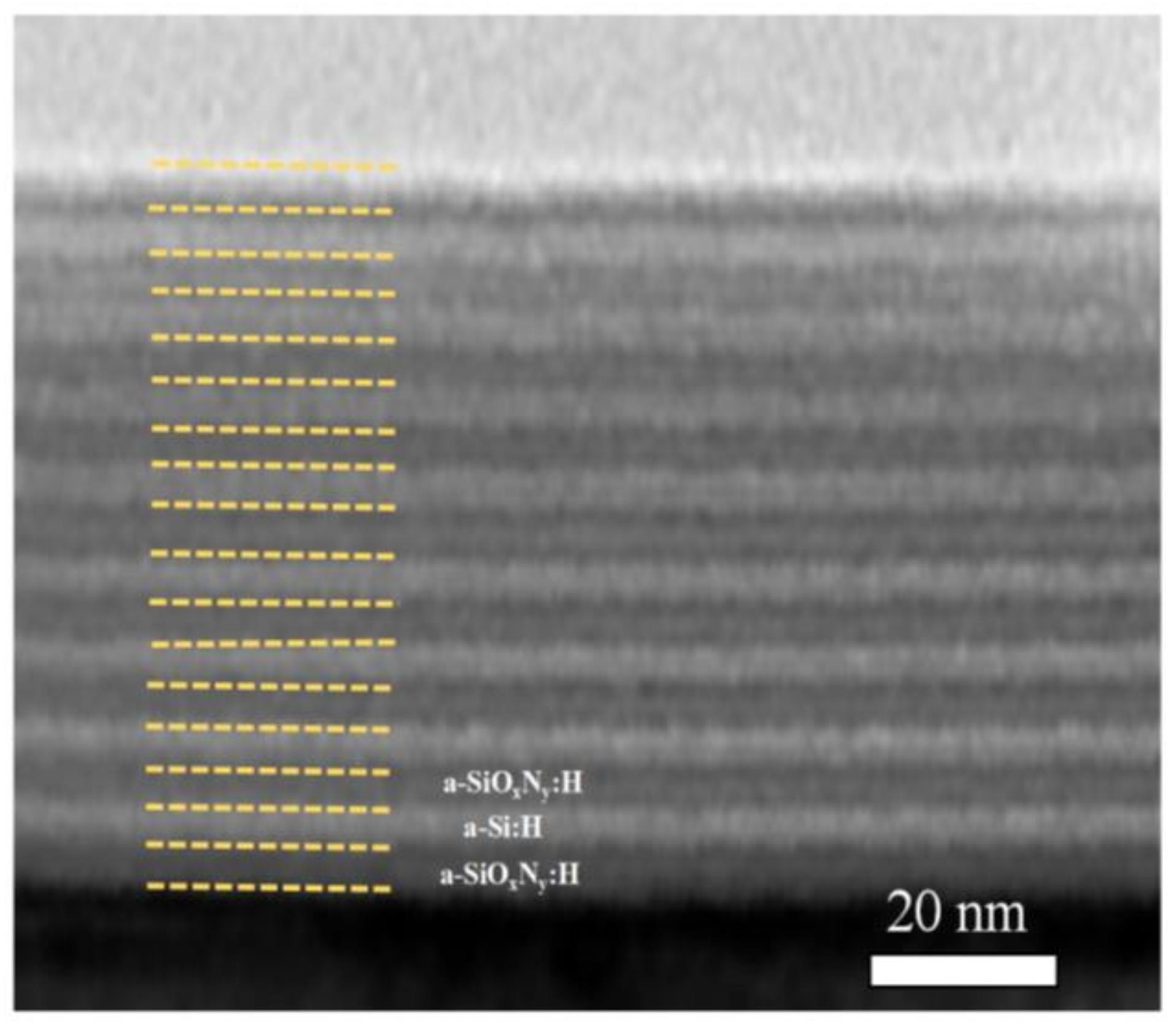
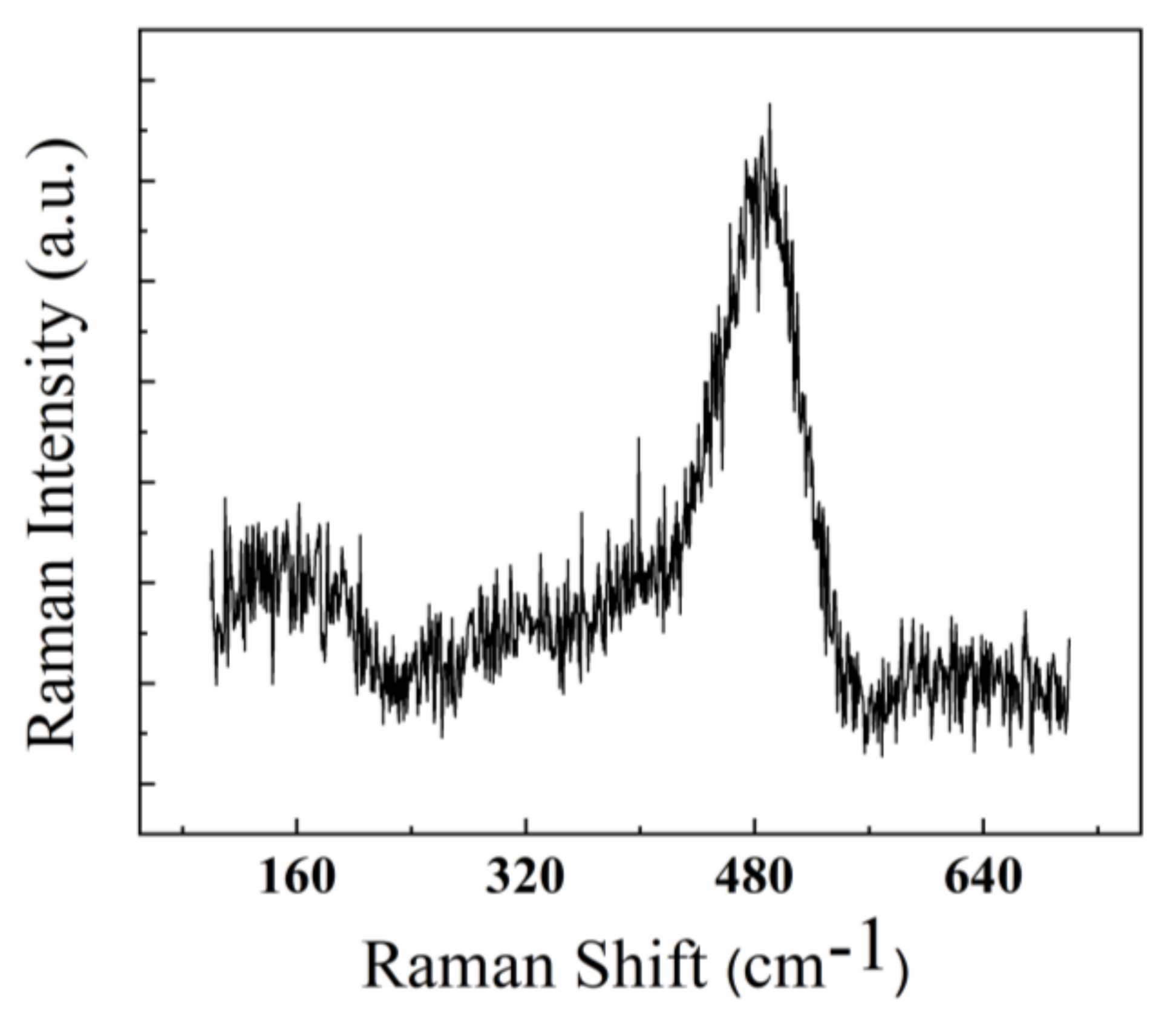

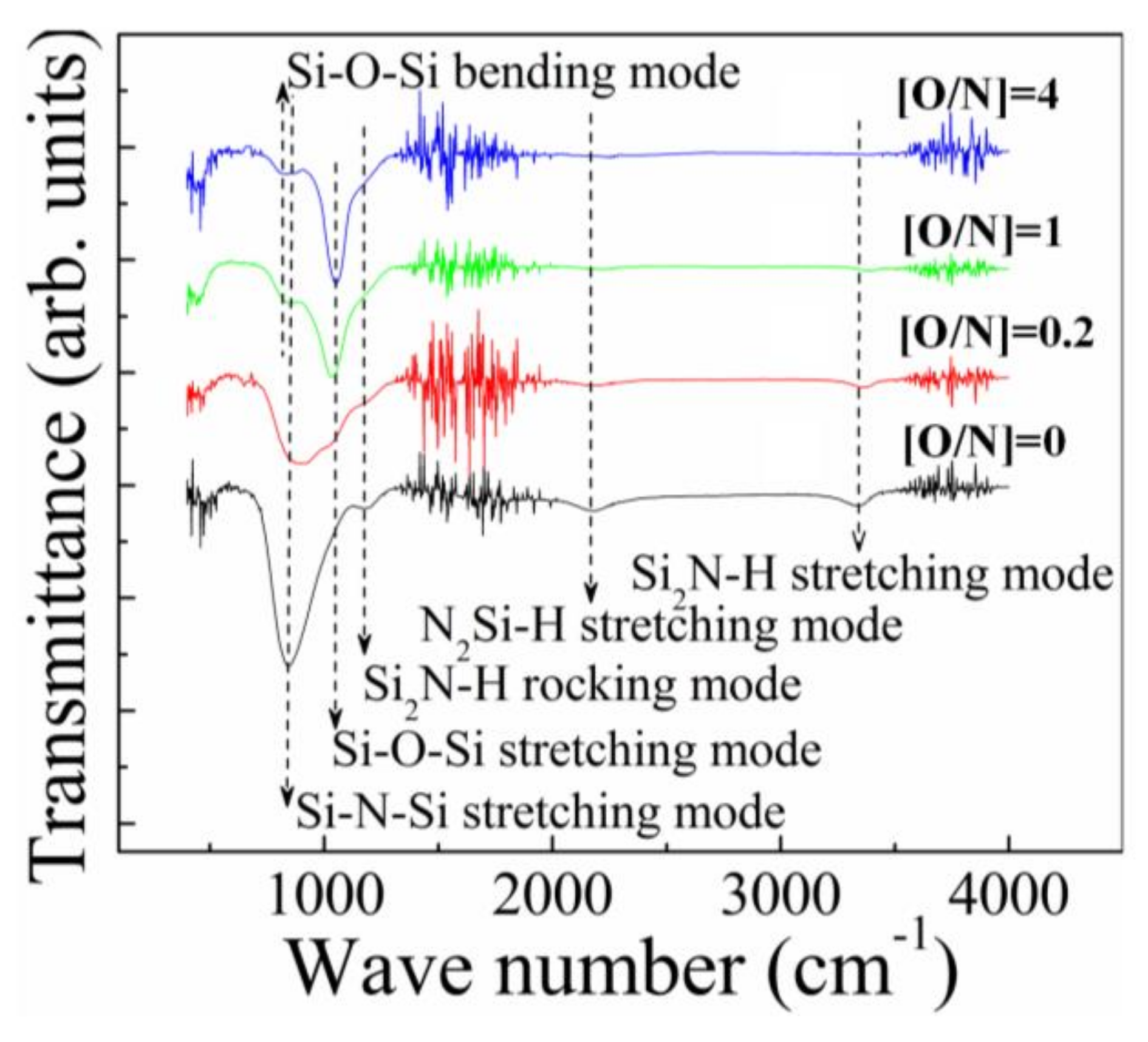
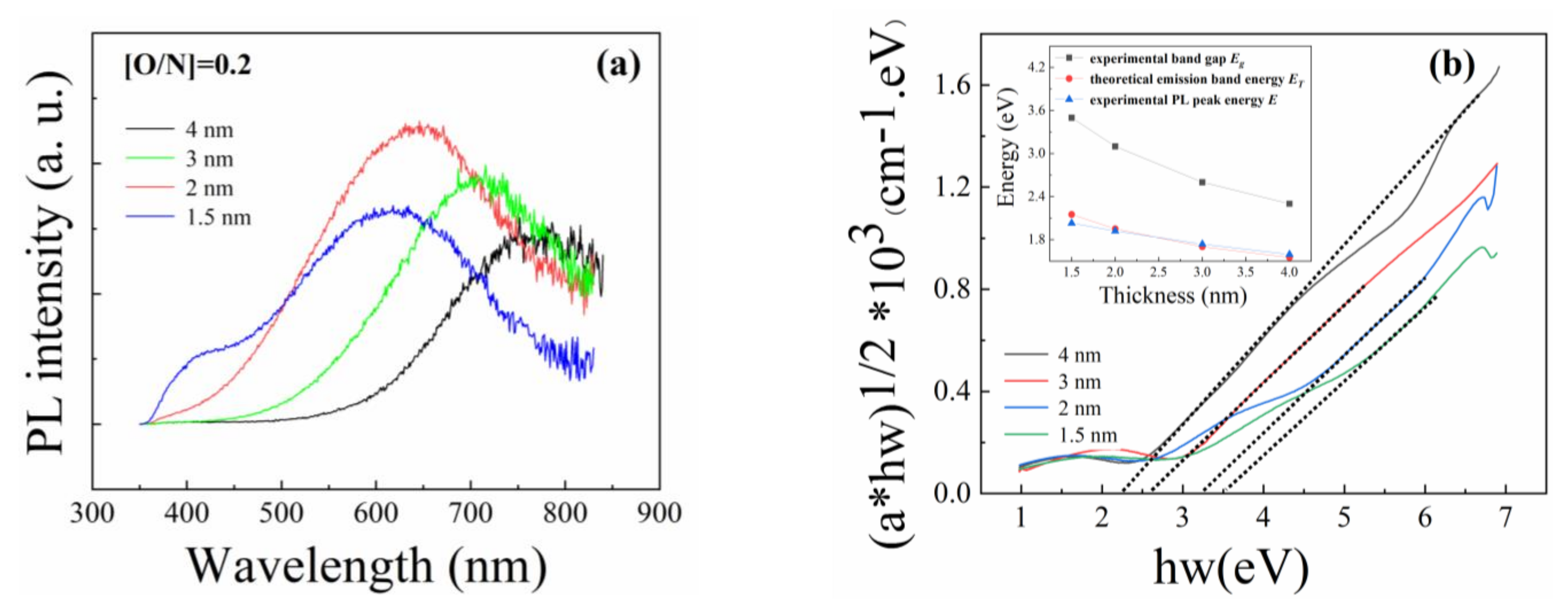
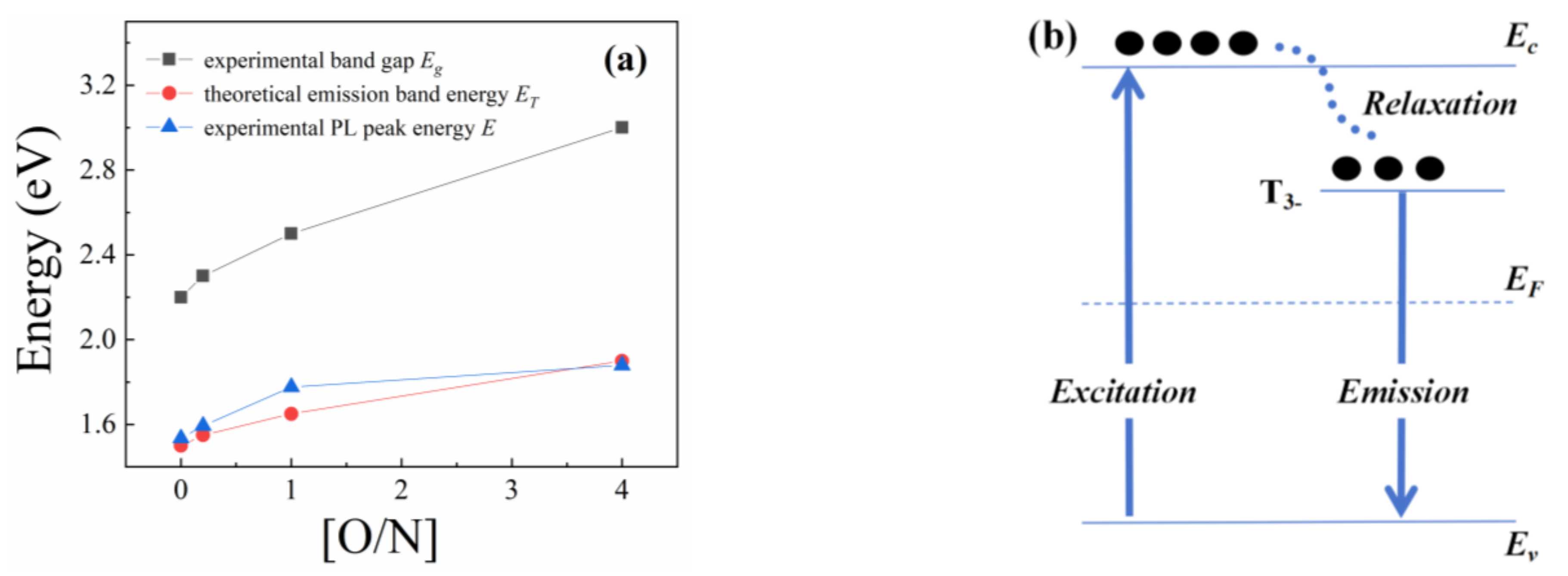

| Sample | SiOxNy:H Sublayer | a-Si Sublayer | ||||||
|---|---|---|---|---|---|---|---|---|
| SiH4 (sccm) | NH3 (sccm) | O2 (sccm) | [O/N] | Thickness (nm) | SiH4 (sccm) | H2 (sccm) | Thickness (nm) | |
| A | 2.5 | 15 | - | 0 | 4 | 1.5 | 160 | 4 |
| B | 2.5 | 15 | 1.5 | 0.2 | 4 | 1.5 | 160 | 4 |
| C | 2.5 | 10 | 5 | 1 | 4 | 1.5 | 160 | 4 |
| D | 2.5 | 5 | 10 | 4 | 4 | 1.5 | 160 | 4 |
| E | 2.5 | 15 | - | 0 | 4 | 1.5 | 160 | 3 |
| F | 2.5 | 15 | - | 0 | 4 | 1.5 | 160 | 2 |
| G | 2.5 | 15 | - | 0 | 4 | 1.5 | 160 | 1.5 |
| H | 2.5 | 15 | 1.5 | 0.2 | 4 | 1.5 | 160 | 3 |
| I | 2.5 | 15 | 1.5 | 0.2 | 4 | 1.5 | 160 | 2 |
| J | 2.5 | 15 | 1.5 | 0.2 | 4 | 1.5 | 160 | 1.5 |
| K | 2.5 | 10 | 5 | 1 | 4 | 1.5 | 160 | 3 |
| L | 2.5 | 10 | 5 | 1 | 4 | 1.5 | 160 | 2 |
| M | 2.5 | 10 | 5 | 1 | 4 | 1.5 | 160 | 1.5 |
| N | 2.5 | 5 | 10 | 4 | 4 | 1.5 | 160 | 3 |
| O | 2.5 | 5 | 10 | 4 | 4 | 1.5 | 160 | 2 |
| P | 2.5 | 5 | 10 | 4 | 4 | 1.5 | 160 | 1.5 |
Disclaimer/Publisher’s Note: The statements, opinions and data contained in all publications are solely those of the individual author(s) and contributor(s) and not of MDPI and/or the editor(s). MDPI and/or the editor(s) disclaim responsibility for any injury to people or property resulting from any ideas, methods, instructions or products referred to in the content. |
© 2024 by the authors. Licensee MDPI, Basel, Switzerland. This article is an open access article distributed under the terms and conditions of the Creative Commons Attribution (CC BY) license (https://creativecommons.org/licenses/by/4.0/).
Share and Cite
Song, C.; Song, J.; Wang, X. Interface and Size Effects of Amorphous Si/Amorphous Silicon Oxynitride Multilayer Structures on the Photoluminescence Spectrum. Coatings 2024, 14, 977. https://doi.org/10.3390/coatings14080977
Song C, Song J, Wang X. Interface and Size Effects of Amorphous Si/Amorphous Silicon Oxynitride Multilayer Structures on the Photoluminescence Spectrum. Coatings. 2024; 14(8):977. https://doi.org/10.3390/coatings14080977
Chicago/Turabian StyleSong, Chao, Jie Song, and Xiang Wang. 2024. "Interface and Size Effects of Amorphous Si/Amorphous Silicon Oxynitride Multilayer Structures on the Photoluminescence Spectrum" Coatings 14, no. 8: 977. https://doi.org/10.3390/coatings14080977





